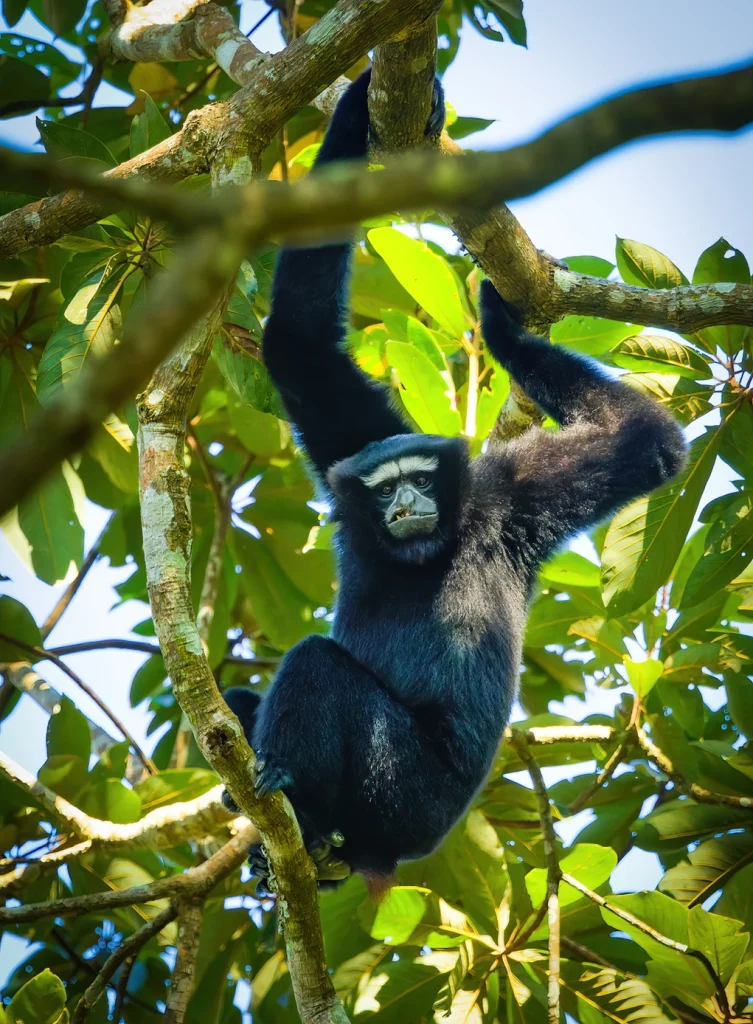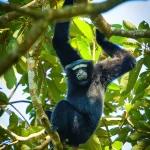Government of India has approved a proposal by Vedanta Group’s Cairn Oil and Gas to carry out oil and gas exploration in the eco-sensitive zone of the Hollongapar Gibbon Wildlife Sanctuary in Assam’s Jorhat district. Cairn Oil and Gas is a private sector oil and gas exploration and production company, contributing a quarter of India’s domestic crude production. However, this clearance for exploratory drilling will prove disastrous for the endangered primates living in the sanctuary. The Gibbons in Hollongapar are very vulnerable. They have already lost a considerable part of their habitat for different reasons. Further loss of habitat will put them in the IUCN Red List. This will bring bad name for the governments of Assam and India as the governments have been party to the approval of mining in the sanctuary. Gibbons need continuous canopy, but mining in the sanctuary or its eco-sensitive zone (ESZ), will lead to fragmentation of the forest and thereby division of the canopies. Any mining activity in the ESZ will seriously affect the living of the Gibbons as continuity of the canopies will be done away with.
The project site is located 13 kilometres from the Hollongapar Gibbon Wildlife Sanctuary. It covers total 4.5 hectares area, which includes a 1.44-hectare well pad and a 3.06-hectare access road, all of them situated within the eco-sensitive zone. The Standing Committee of the National Board for Wildlife (NBWL) of Government of India accorded the necessary approval to the proposal during in its meeting held on December 21 last year. Earlier the principal chief conservator of forests (wildlife) of Assam and chief wildlife warden of Assam had recommended the project citing “national interest”. The Forest Advisory Committee of the Union Environment Ministry had also granted approval during its meeting on August 27.
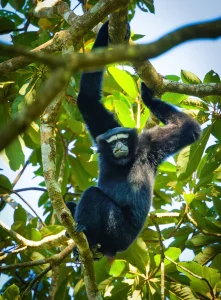
Male Gibbon, Photo by Dr Dhiman Adhikary
According to the inspection team comprising officials from the Union Environment Ministry, the Wildlife Institute of India (WII), and the Assam Forest Department, the exploratory drilling would cause minimal damage, and also that commercial drilling would not be allowed. The Vedanta Group has given a written assurance that no commercial drilling will be conducted at the site. The report recommended no oil or gas extraction from within the eco-sensitive zone, even if reserves were discovered.
However, the exploratory drilling would certainly lead to commercial drilling. Otherwise, such a drilling was not necessary at all. So, the fact that the report recommended no oil or gas extraction from within the eco-sensitive zone, even if reserves were discovered, is completely meaningless and will be conveniently ignored in future. The alibi of ‘national interest’ already gives indication of that. But the ‘national interest’ of augmenting crude oil production in India becomes secondary before the global interest of keeping the Gibbons alive.
The Vedanta Group also reportedly assured that no hazardous substances would be used during the exploration process. But the spill-over of crude oil will itself lead to soil pollution in the ESZ. This has been witnessed in numerous oil wells of Assam already. The electricity connection and any possible fire may also lead to something like the infamous 2020 gas and oil leak incident at Baghjan. Drilling sites are always in danger of future fire; if that happens, almost the entire habitat will be lost as forest fires spread quickly. Incidentally, a railway line passing through the sanctuary is also set to be electrified. This railway line passing through the sanctuary has already cut it into two unequal halves creating problem for the animals’ movements and division of the canopy. This railway line is also likely to be upgraded to double track. All these do not bode well for the sanctuary, especially the Gibbons.
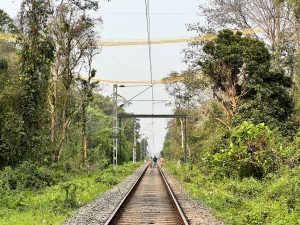
The railway track dividing the sanctuary has overhead bridges for the Gibbons
Photo by Dr Aishimaya Sen Nag
Hollongapar Gibbon Wildlife Sanctuary is named after India’s only ape species, the Hoolock gibbon. It spans 20.98 sq km, while its ESZ covers 264.92 sq km. The large ESZ is necessitated by the fact that Gibbons need continuous canopy for movement. The ESZ ensures a forest corridor connecting the Dissoi Valley Reserve Forest and habitats in Nagaland. Without this, the seven species of primates found in the sanctuary will face a crisis for their very existence. It may also be noted that this sanctuary harbours the highest primate species diversity for any Indian protected area. This highlights the importance of protecting this sanctuary. The Gibbons live in nuclear families. There are 26 such families of Gibbon in this sanctuary with a total population of 106. It may be mentioned that Gibbons have life span of about 35 years.
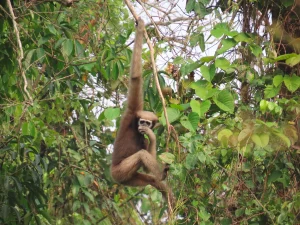
Female Gibbon, Photo by Dr Aishimaya Sen Nag
The sanctuary is also home to more than 60 elephants, over 219 avian species, more than 200 species of butterflies, wild boars, capped langur, stump-tailed macaque, rhesus macaque and the Bengal slow loris, rare insects, reptiles etc. The word Hollongapar is derived from the precious Hollong (Dipterocarpus retusus) trees, abundantly found here. This tall tree with its wide canopy is also crucial for the movement of the Gibbons. Felling of this tree will be a great loss to the bio-diversity as it takes about 50 years for such a tree to mature. It happens to be the state tree of Assam and hence it has a special status.
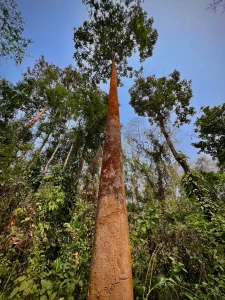
Hollong tree, Photo by Arijit Nag
Moreover, the area where the oil well is proposed is used by elephants. The digging of proposed oil well will therefore hinder the elephant movement, leading to disarray. It will further intensify the already existing human-elephant conflict in this area as elephants will enter human habitation. The elephant herds now venture into the Tiruhil, Disoi Valley, and the Disoi forests. The oil and gas exploration will disrupt these movements, leading to a total disarray. These elephants will also stray into the surrounding areas in Golaghat and Nagaon district, where people have already suffered a lot from elephant attacks. So, the proposed oil and gas exploration activity in the eco-sensitive zone of the Hollongapar Gibbon Wildlife Sanctuary will have far-reaching fall-out over a large part of Assam.
[Prepared with inputs from different sources. Bengali version of this article is published in https://www.boneypahare.com/]
